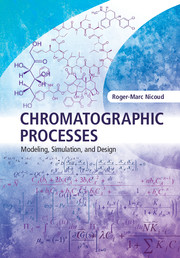Book contents
- Frontmatter
- Contents
- Preface and acknowledgments
- 1 Our approach to modeling chromatographic processes
- 2 Linear chromatography: the Russian Lego
- 3 Non-linear chromatography: equilibrium theory
- 4 Fluid–solid phase equilibria
- 5 Mass transfer
- 6 Hydrodynamics of chromatographic columns
- 7 Simulating chromatographic columns
- 8 Counter-current systems
- 9 Chromatographic modes and their optimization
- 10 Addressing a few industrial problems
- 11 Conclusion
- Appendix A Some important properties of the Laplace transform
- Appendix B Inlet and outlet boundary conditions
- Appendix C Equilibrium theory: single-solute chromatograms
- Appendix D Equilibrium theory: binary chromatograms
- Appendix E The influence of the porosity determination on chromatographic modeling
- Appendix F Useful physico-chemical data and orders of magnitude
- Appendix G Fick and Maxwell–Stefan approaches to diffusion
- Appendix H Non-linear LDF for multi-solute systems
- Appendix I Situations that make the use of the MC model problematic
- Appendix J Typical industrial chromatographic processes
- Notation
- Index
- References
2 - Linear chromatography: the Russian Lego
Published online by Cambridge University Press: 05 April 2015
- Frontmatter
- Contents
- Preface and acknowledgments
- 1 Our approach to modeling chromatographic processes
- 2 Linear chromatography: the Russian Lego
- 3 Non-linear chromatography: equilibrium theory
- 4 Fluid–solid phase equilibria
- 5 Mass transfer
- 6 Hydrodynamics of chromatographic columns
- 7 Simulating chromatographic columns
- 8 Counter-current systems
- 9 Chromatographic modes and their optimization
- 10 Addressing a few industrial problems
- 11 Conclusion
- Appendix A Some important properties of the Laplace transform
- Appendix B Inlet and outlet boundary conditions
- Appendix C Equilibrium theory: single-solute chromatograms
- Appendix D Equilibrium theory: binary chromatograms
- Appendix E The influence of the porosity determination on chromatographic modeling
- Appendix F Useful physico-chemical data and orders of magnitude
- Appendix G Fick and Maxwell–Stefan approaches to diffusion
- Appendix H Non-linear LDF for multi-solute systems
- Appendix I Situations that make the use of the MC model problematic
- Appendix J Typical industrial chromatographic processes
- Notation
- Index
- References
Summary
This chapter is dedicated to Jacques Villermaux.
This chapter presents the basic concepts that allow the modeling of linear chromatographic systems, i.e. systems where the outlet signals (peaks, breakthrough curves) are proportional to the inlet concentration signal.
A chromatographic system can be considered linear at “sufficiently small” concentrations. As a rule of thumb, this is usually the case for concentrations lower than a few g/l for columns packed with silica or reversed phase and lower than 1 g/l on chiral media, whereas the chromatography of sugars is linear up to about 100 g/l on cationic ion-exchange resins. Conversely, when one considers separation of ions on resins (cationic or anionic), the system usually behaves linearly if the ionic fraction of the solute is lower than about 0.05.
In order to increase productivity, the inlet concentrations in preparative chromatography are normally made as high as possible, and the system usually does not behave linearly. Consequently, the theory of linear chromatography is usually not adequate for the comprehensive modeling of preparative chromatography. So why should we spend a fair number of pages describing this matter?
Probably most readers expect to find a rewriting of known analytical solutions for linear chromatography. Those who have looked at a few pages of this chapter have seen Laplace transforms and may fear the worse.
Let me explain why I believe this matter is possibly one of the least described and one of the most important. The theory of linear systems and consequently of linear chromatography mainly provides an efficient investigation tool for the study of hydrodynamics, kinetics and fluid–solid interactions. That is already a lot!
In order to benefit from this approach, one must accept working with the Laplace transform. This will most likely look strange to many chromatographers, as the Laplace transform is, to say the least, not their primary tool.
- Type
- Chapter
- Information
- Chromatographic ProcessesModeling, Simulation, and Design, pp. 20 - 61Publisher: Cambridge University PressPrint publication year: 2015

